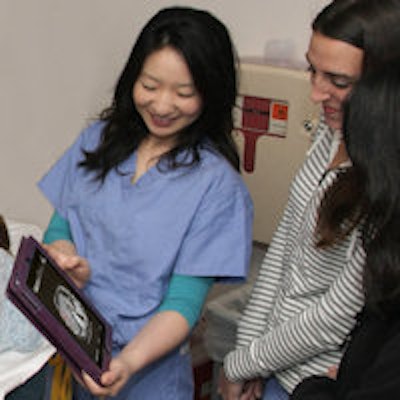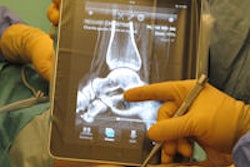
Is the iPad making a big difference in the lives of radiology residents who have them? For education, definitely. For clinical use, not quite yet, though the situation is evolving rapidly, according to a survey in the Journal of the American College of Radiology.
Researchers from Beth Israel Deaconess Medical Center found that a whopping 86% of residents given Apple iPads were using them daily or weekly for their residency education and clinical work. The devices are especially popular for reading journal articles, with more than three-fourths of respondents saying they preferred the iPad over other reading methods. However, the issue of textbooks was a mixed bag, with about half of respondents favoring old-fashioned paper books.
At the time of the survey, the use of iPads for readouts and report editing was still very limited (JACR, February 2014, Vol. 11:2, pp. 180-184). Technology has improved access to PACS images since the survey was completed, and the data show that most residents have incorporated the iPad as an important educational tool and learning aid, lead author and PGY-5 resident Dr. Seth Berkowitz told AuntMinnie.com.
"The iPad has definitely had a very positive impact on residents in our department," he said. "What was interesting about the study is that it shows us that like any tool, it's particularly well-suited for certain things and maybe not as useful in other areas."
The iPad has yet to be as incorporated into clinical workflow, perhaps due in part to the need for a larger screen when reading studies on the PACS, he said.
Not your grandfather's residents
Radiology educators are figuring out that a new crop of "millennial learners" have different needs and preferences than the last generation -- inasmuch as those born after 1980 prefer reading and communicating online.
These learners typically respond well to teaching methods that emphasize multimedia and technology, wrote Berkowitz, along with co-authors Dr. Justin Kung, Dr. Ronald Eisenberg, Dr. Kevin Donohoe, Dr. Leo Tsai, PhD, and Dr. Priscilla Slanetz.
 Beth Israel Deaconess residents pull up images on their iPads. All images courtesy of Dr. Seth Berkowitz.
Beth Israel Deaconess residents pull up images on their iPads. All images courtesy of Dr. Seth Berkowitz.Some members of the healthcare community consider the iPad to be a "revolutionary tool" in healthcare delivery, especially in medical imaging, where it has been used for interoperative procedure planning guidance and mobile interpretation of imaging studies.
Radiology educators have also shown enthusiasm for the device, and recent surveys have found that one-third of all radiology residents own one, Berkowitz and colleagues wrote. What's not quite clear yet is whether the iPad will turn out to be a real tool or more of a toy -- "a gadget or a medical godsend," as the authors put it.
"At our institution, we're very excited about trends in technology, especially mobile computing," Berkowitz said. "But we wanted to assess the impact it was having after we deployed the iPad to actually see what people were doing with it," both for educational and clinical tasks.
iPads for all
The residency program purchased iPad 2 models (64 GB, flash storage, Wi-Fi only) for each of its 38 residents and trained them on the device's security features. The participants were also instructed on applicable HIPAA policies.
Six months after they started using the devices, the survey was conducted anonymously online (SurveyMonkey) to probe use patterns and preferences. It included multiple choice and Likert-style questions; for the latter, 1 indicated "strongly disagree" and 5 meant "strongly agree."
Thirty-six (95%) of the 38 residents responded to the survey. The results were surprising in a few different ways, according to Berkowitz and colleagues. For example, when students were asked whether they prefer to read journal articles on paper, a computer, or the iPad, 70% (23 of 33) preferred the iPad. However, textbooks were a different story: half preferred the iPad (48%, 16 of 33) and half preferred traditional textbooks.
Education, not workflow
Overall, residents considered the iPad a valuable tool in their education (4.1 Likert score). They mostly agreed the iPad was useful during didactic and case-based conferences (3.6), and they felt the iPad enhanced learning during conferences (3.9) and was not a distraction (2.1). However, it's possible that residents were underestimating the level of distraction, the authors noted.
Image interpretation results were a little trickier. Respondents generally felt they could identify important radiographic abnormalities on their iPads (3.5 score) -- but 75% said they had never attempted to do so.
Berkowitz noted a couple of important issues that hampered residents' ability to use the iPad clinically.
 PGY-5 resident Dr. Seth Berkowitz.
PGY-5 resident Dr. Seth Berkowitz.
"During our normal workday, we're in front of PACS workstations with three or four monitors, so an additional 9.7-inch screen isn't necessarily useful in that situation," he said. Even then, though, the iPad is "sometimes useful if your attending is using the PACS station and you want to look up an article or images on a secondary screen."
Another issue that might have prevented wider clinical use was the difficulty of actually accessing PACS images on the device during the study -- a problem that has since been corrected.
"We did not have an easy way to access images from our iPads," he said. "It was possible, but only through a remote desktop solution using Citrix." In fact, just over 6% of residents reported using this solution to view images.
"In mobile, we're used to things being very user-friendly; modern users don't have the patience to jump through several hoops," Berkowitz said.
But things have gotten easier since the study ended: The group deployed a homegrown app that is yielding "huge growth in residents using the iPad for clinical purposes," he said.
These days, another key clinical use is when residents are at home signing radiology reports. They're able to easily reference and double-check images while they're producing the reports.
Finally, iPads are also gaining ground in his residents' radiologist-patient conferences. "Residents are using the iPad to meet with patients and discuss the images with them, and really put a face on the process and what we do," Berkowitz said.
Popular apps
The most popular radiology application was e-Anatomy, a subscription service that replaces traditional cross-sectional anatomy atlases with scrollable, annotated, cross-sectional images, the authors wrote. Other popular radiology applications included the RadioGraphics and Radiology journals, used at least once by more than 70% of residents; the diagnostic reference STATdx (Amirsys), used daily by nearly one-fourth of residents; and several applications for annotating, organizing, and searching through PDF files.
Note-taking applications such as Evernote remain popular with residents for taking notes during lectures, but there's peril in the potential to include protected health information (PHI) in nonencrypted note-taking apps, Berkowitz said.
"One of the challenges in mobile is that we're inundated with really fantastic and useful consumer services like cloud storage apps [e.g., Dropbox] and note-taking services," he said. "There's a temptation to use these services in our work, and there is a need for constant education not to use the apps for PHI even though they're incredibly useful." Dropbox was used daily by one-fourth of all residents; note-taking software was used daily by 25%.
Regarding the preferences for reading journals or textbooks on an iPad or in print, the potential for eyestrain perhaps was a factor, Berkowitz said. Also, many textbooks were available in the traditional print form in the resident library.
"The prices of e-books, although slightly lower at this point, are not dramatically so," Berkowitz said. "So there's some reluctance for students to spend that much for e-books when for a little more they can have a copy. In a perfect world, you would have access to the e-version when you purchase a physical book."
An all-digital world
The study represents changing trends in how people get information -- even in radiology.
"There's a generational shift happening: The current generation of residents is in the midst of a transition to an all-digital world," Berkowitz said. "As we get residents who have been living their whole lives in the digital world, they'll be comfortable with making digital-only purchases."
In fact, each year, the trend toward digital learning is stronger, with the latest crop of first-year residents quite different from the seniors in terms of their desire learn 100% digitally, he said. And thanks to continued funding, the program will continue furnishing residents with iPads and studying the effects.



















